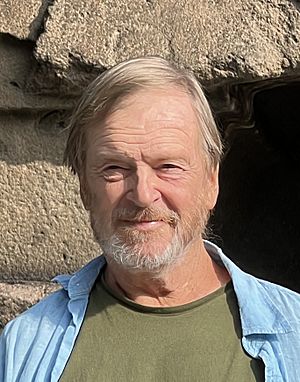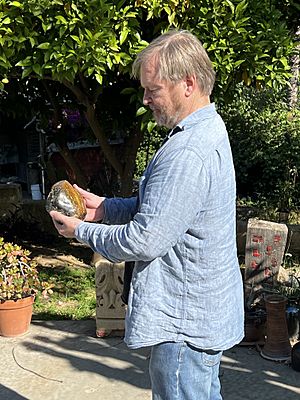Karl Taube facts for kids
Quick facts for kids
Karl Andreas Taube
|
|
|---|---|

Karl Taube, an American expert on ancient cultures, in 2022.
|
|
| Born | September 14, 1957 |
| Parent(s) | Henry Taube |
Karl Andreas Taube (born September 14, 1957) is an American expert who studies the ancient cultures of Mesoamerica (an area that includes Mexico and parts of Central America). He is a type of historian and scientist known as a Mesoamericanist and Mayanist.
Taube is also an iconographer, which means he is an expert at understanding the meaning behind the art and symbols of ancient peoples. He has spent his career researching cultures that existed long before Christopher Columbus came to the Americas, especially in Mesoamerica and the American Southwest.
He works as a Distinguished Professor of Anthropology at the University of California, Riverside.
Contents
Early Life and Education
Karl Taube grew up in a family focused on science. His father, Henry Taube, was a famous chemist who won the Nobel Prize in Chemistry in 1983.
For his own education, Karl first went to Stanford and then to the Berkeley, where he earned a degree in anthropology in 1980. He then went to Yale for more advanced studies. At Yale, he learned from famous Maya experts like Michael D. Coe and Mary Miller. With Mary Miller, he later wrote a popular encyclopedia called The Gods and Symbols of Ancient Mexico and the Maya. He finished his studies at Yale in 1988.
A Career of Discovery
Throughout his career, Taube has worked on many research projects. He has traveled to the highlands of Chiapas in Mexico, the Yucatán Peninsula, central Mexico, Honduras, and Guatemala to study ancient sites.
Since 2003, Taube has been the main iconographer for the San Bartolo project in Guatemala. His job is to figure out the meaning of ancient paintings, called murals, found there. These murals are very old, dating back to the first century B.C.
In 2004, Taube helped lead a team that discovered new sources of a special blue-green stone called jadeite in Guatemala. This type of jade was prized by the ancient Olmec people. Taube has also studied ancient sites in Ecuador and Peru.
Uncovering Ancient Secrets
Taube has written several important books and articles that have changed how we understand ancient cultures.
Gods and Symbols
One of his most famous books is "The Major Gods of Ancient Yucatan" (1992). In it, he studied the gods of the Maya people and connected them to older versions of the same gods from an earlier time period. He also helped explain the story of the Maya maize god and the hero Hunahpu by studying the murals at San Bartolo.
The Importance of Corn
A key topic for Taube is farming, especially the importance of maize (corn) in ancient Mesoamerica. He showed how the Maya maize god was a central figure in Maya beliefs. He also studied how ideas about corn connected different cultures, from the Olmec in Mexico to the native peoples of the American Southwest.
Connecting Ancient Worlds
Taube is very interested in how different ancient groups interacted with each other. He has studied the connections between the great city of Teotihuacan in central Mexico and the Maya cities that existed at the same time. He also explored how ideas about life, beauty, and paradise were shared among different cultures.
In May 2023, Taube wrote about an important Olmec carving of an "Earth monster" that had been stolen from a site in Mexico called Chalcatzingo. He celebrated its return to Mexico. A few months later, in July 2023, he gave lectures in Beijing, China, about Mesoamerican history and jade.
Sharing His Knowledge
Taube shares his passion for archaeology by leading educational trips for a company called Far Horizons. People can travel with him to see ancient sites and learn about them firsthand.
- Far Horizons Archaeological and Cultural trips
- Karl Taube's tour page
See also
 In Spanish: Karl Taube para niños
In Spanish: Karl Taube para niños


